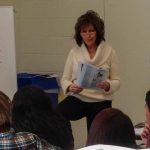 At Teach to Work, we continue to hear exciting news from Arizona State University (“ASU”) and its continuing efforts to design a Next Education Workforce that leverage teams of educators with distributed expertise to deepen and personalize learning for all students. As part of this work, they are adding “Community Educators” onto these teams. A year ago, I reported on their initial goals and observations. Through its Mary Lou Fulton Teachers College, ASU is working with 16 school districts to build Next Education Workforce models and has begun to study how Community Educators are having an impact in the classroom.
At Teach to Work, we continue to hear exciting news from Arizona State University (“ASU”) and its continuing efforts to design a Next Education Workforce that leverage teams of educators with distributed expertise to deepen and personalize learning for all students. As part of this work, they are adding “Community Educators” onto these teams. A year ago, I reported on their initial goals and observations. Through its Mary Lou Fulton Teachers College, ASU is working with 16 school districts to build Next Education Workforce models and has begun to study how Community Educators are having an impact in the classroom.
ASU recently conducted a study to learn about teachers’ and administrators’ perceptions, beliefs, and interests in having Community Educators as part of their team teaching models.
I’m pleased to report that the study results suggest the potential of this remarkable program.
Tellingly, the report began with this fundamental insight: “Teachers often try to meet every need of every student on their own. Expecting teachers to do so is unreasonable — and there are other options.” The report continues with “Community educators can provide academic and social support for students, helping teachers deepen and personalize learning for each student. Networks of community educators expand students’ social networks, providing access to diverse knowledge and experience.”
As a refresher, ASU uses the term “community educators” to refer to “talented adults from the community who bring additional capacity, insight and expertise to learning environments.” In contrast to volunteers who work with students once or twice a year, these community educators play an active and recurring role in students’ growth and development. These community educators include what we commonly call mentors.
Over the course of numerous interviews with administrators, teachers, and mentors, ASU asked how the schools were collaborating with their community educators, and how participants perceived the collaboration. Topics ranged from what was learned through the collaboration to what barriers existed. What follows are the observations ASU’s research uncovered.
As far as what knowledge, disposition, and skills mentors needed, ASU found that mentors were more effective when they reinforced the strategies that classroom teachers promoted. ASU found that it was important to understand the abilities of different ages of students and to adapt a mentor’s approaches and vocabulary for the students they mentored. The best mentors were able to communicate well with students and presented content in interactive and engaging ways. Ideal mentors also exhibited creativity and imagination, communicated well with faculty, and were prepared to support students in an appropriate manner, including being able to set clear boundaries.
ASU also found that the dispositions of mentors was critical to their success. Ideal mentors were able to adapt to new situations, “remain committed and reliant in the face of challenges,” and “show enthusiasm and positivity.”
I believe most people can have these dispositions with training. I have discussed this at length in blogs and a video tutorial that you can find on www.TeachToWork.com. And note that mentors can come in all types of disciplines – I’ve seen everyone from accountants to zoologists make excellent mentors. If you are even considering it, I encourage you to read Teach to Work chapters 4-10, which provides step-by-step guidance for mentors.
For barriers, ASU found that the most prominent barrier was the process for identifying the mentors. “Participants noted sometimes it is difficult to identify people or organizations who could help.” Secondly, it was sometimes difficult to get parents or volunteers to complete the paperwork.
Finally, ASU concludes in its study that the mentorship programs being initiated in school districts are “incredible collaborations” that can be scaled as the barriers are overcome. ASU states (and I wholeheartedly agree) that first, a process and system for identifying mentors should be put in place. From there, the mentor’s registration process should be clear and simple.
Teach to Work offers a free Implementation Guide that can help with both of these steps. We sincerely hope that anyone looking to implement or improve their mentorship program not recreate the wheel, but utilize the proven resources we already have to make these steps as easy as possible.
ASU’s final recommendation is to provide ongoing training for the mentors through on-demand and online modules. Once again, if you don’t already have training established, or if you want to compare your training to what we have been doing for decades, we encourage you to check out our video tutorials, which can be accessed here.
I commend ASU and Arizona for their successes and desire to implement mentorship on a larger scale. If you want to explore doing the same, please reach out to us!
Read the report: Building a Network of Community Educators, by ASU’s Mary Lou Fulton Teachers College


